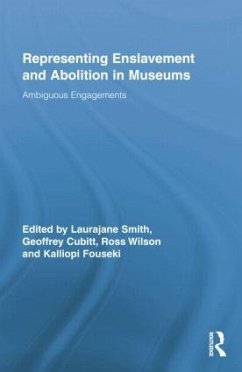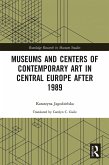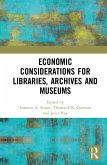Representing Enslavement and Abolition in Museums
Ambiguous Engagements
Herausgeber: Smith, Laurajane; Fouseki, Kalliopi; Cubitt, Geoff
Representing Enslavement and Abolition in Museums
Ambiguous Engagements
Herausgeber: Smith, Laurajane; Fouseki, Kalliopi; Cubitt, Geoff
- Broschiertes Buch
- Merkliste
- Auf die Merkliste
- Bewerten Bewerten
- Teilen
- Produkt teilen
- Produkterinnerung
- Produkterinnerung
This book reflects on the complexity and difficulty of museums' experiences in presenting and interpreting the histories of slavery and abolition. It draws together contributions from academics, museum professionals, community activists and artists who were involved in marking the bicentenary of Britain¿s abolition of the slave trade.
Andere Kunden interessierten sich auch für
![Representing Enslavement and Abolition in Museums Representing Enslavement and Abolition in Museums]() Representing Enslavement and Abolition in Museums207,99 €
Representing Enslavement and Abolition in Museums207,99 €![Reculturing Museums Reculturing Museums]() Doris B. AshReculturing Museums196,99 €
Doris B. AshReculturing Museums196,99 €![Human Rights Museums Human Rights Museums]() Jennifer CarterHuman Rights Museums195,99 €
Jennifer CarterHuman Rights Museums195,99 €![Museums and Centers of Contemporary Art in Central Europe after 1989 Museums and Centers of Contemporary Art in Central Europe after 1989]() Katarzyna Jagodzi¿skaMuseums and Centers of Contemporary Art in Central Europe after 198963,99 €
Katarzyna Jagodzi¿skaMuseums and Centers of Contemporary Art in Central Europe after 198963,99 €![Economic Considerations for Libraries, Archives and Museums Economic Considerations for Libraries, Archives and Museums]() Economic Considerations for Libraries, Archives and Museums195,99 €
Economic Considerations for Libraries, Archives and Museums195,99 €![International Thinking on Children in Museums International Thinking on Children in Museums]() International Thinking on Children in Museums195,99 €
International Thinking on Children in Museums195,99 €![Fundraising for Impact in Libraries, Archives, and Museums Fundraising for Impact in Libraries, Archives, and Museums]() Kathryn K. MatthewFundraising for Impact in Libraries, Archives, and Museums196,99 €
Kathryn K. MatthewFundraising for Impact in Libraries, Archives, and Museums196,99 €-
-
-
This book reflects on the complexity and difficulty of museums' experiences in presenting and interpreting the histories of slavery and abolition. It draws together contributions from academics, museum professionals, community activists and artists who were involved in marking the bicentenary of Britain¿s abolition of the slave trade.
Hinweis: Dieser Artikel kann nur an eine deutsche Lieferadresse ausgeliefert werden.
Hinweis: Dieser Artikel kann nur an eine deutsche Lieferadresse ausgeliefert werden.
Produktdetails
- Produktdetails
- Verlag: Routledge
- Seitenzahl: 352
- Erscheinungstermin: 30. Mai 2014
- Englisch
- Abmessung: 229mm x 152mm x 19mm
- Gewicht: 510g
- ISBN-13: 9781138802261
- ISBN-10: 1138802263
- Artikelnr.: 40719250
- Herstellerkennzeichnung
- Libri GmbH
- Europaallee 1
- 36244 Bad Hersfeld
- gpsr@libri.de
- Verlag: Routledge
- Seitenzahl: 352
- Erscheinungstermin: 30. Mai 2014
- Englisch
- Abmessung: 229mm x 152mm x 19mm
- Gewicht: 510g
- ISBN-13: 9781138802261
- ISBN-10: 1138802263
- Artikelnr.: 40719250
- Herstellerkennzeichnung
- Libri GmbH
- Europaallee 1
- 36244 Bad Hersfeld
- gpsr@libri.de
Laurajane Smith is Australian Research Council Future Fellow in the School of Archaeology and Anthropology, Research School of Humanities and the Arts, the Australian National University, Canberra. She is author of Uses of Heritage (2006) and Archaeological Theory and the Politics of Cultural Heritage (2004), co-author of Heritage, Communities and Archaeology (2009) and co-editor of Intangible Heritage (2009). She is editor of the International Journal of Heritage Studies. Geoff Cubitt is a Senior Lecturer in the History Department and in the Centre for Eighteenth Century Studies at the University of York. He is the author of the books, The Jesuit Myth (1993) and History and Memory (2007), and editor of two others, Imagining Nations (1998) and Heroic Reputations and Exemplary Lives (2000). Kalliopi Fouseki is a Post-Doctoral Research Assistant on the 1807 Commemorated project in the Department of Archaeology at the University of York. Ross Wilson is a Post-Doctoral Research Assistant on the 1807 Commemorated project in the Department of History at the University of York.
1. Introduction: Anxiety and Ambiguity in The Representation of Dissonant
History. Geoff Cubitt, Laurajane Smith, Ross Wilson Part I: Organizing the
Bicentenary: Politics and Policy 2. The Burden of Knowing Versus the
Privilege of Unknowing. Emma Waterton 3. High Anxiety - 2007 and
Institutional Neuroses. Roshi Naidoo 4. Restoring the Pan African
Perspective: Reversing the Institutionalization of Maafa Denial. Toyin
Agbetu 5. Slavery and the (Symbolic) Politics of Memory in Jamaica:
Rethinking the Bicentenary. Wayne Modest Part II: Representing the
Bicentenary: Communities, Consultants and Curators 6. The Role of Museums
as 'Places of Social Justice': Community Consultation and the 1807
Bicentenary. Laurajane Smith and Kalliopi Fouseki 7. Science and Slavery,
2007 - Public Consultation. Tracy-Ann Smith 8. The Curatorial Complex:
Marking the Bicentenary of the Abolition of the Slave Trade. Ross Wilson
Part III: Marking the Bicentenary: Exhibitions, Art and Personal
Reflections 9. Making the London Sugar and Slavery Gallery at Museum of
London Docklands. David Spence 10. Terra Nova for the Royal Geographical
Society: 2007 and the Bombay African Strand Of the 'Crossing Continents:
Connecting Communities' Project. Cliff Pereira and Vandana Patel 11.
Exhibiting Difference: A Curatorial Journey with George Alexander Gratton
the 'Spotted Negro Boy'. Temi-Tope Odumosu 12. Art, Resistance and
Remembrance: A Bicentenary at the British Museum. Christopher Spring 13.
Maybe There Was Something to Celebrate. Raimi Gbadamosi Part IV:
Encountering the Bicentenary: Trauma and Engagement 14. Atrocity Materials
and the Representation of Transatlantic Slavery: Problems, Strategies and
Reactions. Geoff Cubitt 15. Affect and Registers of Engagement: Navigating
Emotional Responses to Dissonant Heritages. Laurajane Smith 16.
Commemorating Civil Rights and Reform Movements at the National Museum of
American History. Kylie Message
History. Geoff Cubitt, Laurajane Smith, Ross Wilson Part I: Organizing the
Bicentenary: Politics and Policy 2. The Burden of Knowing Versus the
Privilege of Unknowing. Emma Waterton 3. High Anxiety - 2007 and
Institutional Neuroses. Roshi Naidoo 4. Restoring the Pan African
Perspective: Reversing the Institutionalization of Maafa Denial. Toyin
Agbetu 5. Slavery and the (Symbolic) Politics of Memory in Jamaica:
Rethinking the Bicentenary. Wayne Modest Part II: Representing the
Bicentenary: Communities, Consultants and Curators 6. The Role of Museums
as 'Places of Social Justice': Community Consultation and the 1807
Bicentenary. Laurajane Smith and Kalliopi Fouseki 7. Science and Slavery,
2007 - Public Consultation. Tracy-Ann Smith 8. The Curatorial Complex:
Marking the Bicentenary of the Abolition of the Slave Trade. Ross Wilson
Part III: Marking the Bicentenary: Exhibitions, Art and Personal
Reflections 9. Making the London Sugar and Slavery Gallery at Museum of
London Docklands. David Spence 10. Terra Nova for the Royal Geographical
Society: 2007 and the Bombay African Strand Of the 'Crossing Continents:
Connecting Communities' Project. Cliff Pereira and Vandana Patel 11.
Exhibiting Difference: A Curatorial Journey with George Alexander Gratton
the 'Spotted Negro Boy'. Temi-Tope Odumosu 12. Art, Resistance and
Remembrance: A Bicentenary at the British Museum. Christopher Spring 13.
Maybe There Was Something to Celebrate. Raimi Gbadamosi Part IV:
Encountering the Bicentenary: Trauma and Engagement 14. Atrocity Materials
and the Representation of Transatlantic Slavery: Problems, Strategies and
Reactions. Geoff Cubitt 15. Affect and Registers of Engagement: Navigating
Emotional Responses to Dissonant Heritages. Laurajane Smith 16.
Commemorating Civil Rights and Reform Movements at the National Museum of
American History. Kylie Message
1. Introduction: Anxiety and Ambiguity in The Representation of Dissonant
History. Geoff Cubitt, Laurajane Smith, Ross Wilson Part I: Organizing the
Bicentenary: Politics and Policy 2. The Burden of Knowing Versus the
Privilege of Unknowing. Emma Waterton 3. High Anxiety - 2007 and
Institutional Neuroses. Roshi Naidoo 4. Restoring the Pan African
Perspective: Reversing the Institutionalization of Maafa Denial. Toyin
Agbetu 5. Slavery and the (Symbolic) Politics of Memory in Jamaica:
Rethinking the Bicentenary. Wayne Modest Part II: Representing the
Bicentenary: Communities, Consultants and Curators 6. The Role of Museums
as 'Places of Social Justice': Community Consultation and the 1807
Bicentenary. Laurajane Smith and Kalliopi Fouseki 7. Science and Slavery,
2007 - Public Consultation. Tracy-Ann Smith 8. The Curatorial Complex:
Marking the Bicentenary of the Abolition of the Slave Trade. Ross Wilson
Part III: Marking the Bicentenary: Exhibitions, Art and Personal
Reflections 9. Making the London Sugar and Slavery Gallery at Museum of
London Docklands. David Spence 10. Terra Nova for the Royal Geographical
Society: 2007 and the Bombay African Strand Of the 'Crossing Continents:
Connecting Communities' Project. Cliff Pereira and Vandana Patel 11.
Exhibiting Difference: A Curatorial Journey with George Alexander Gratton
the 'Spotted Negro Boy'. Temi-Tope Odumosu 12. Art, Resistance and
Remembrance: A Bicentenary at the British Museum. Christopher Spring 13.
Maybe There Was Something to Celebrate. Raimi Gbadamosi Part IV:
Encountering the Bicentenary: Trauma and Engagement 14. Atrocity Materials
and the Representation of Transatlantic Slavery: Problems, Strategies and
Reactions. Geoff Cubitt 15. Affect and Registers of Engagement: Navigating
Emotional Responses to Dissonant Heritages. Laurajane Smith 16.
Commemorating Civil Rights and Reform Movements at the National Museum of
American History. Kylie Message
History. Geoff Cubitt, Laurajane Smith, Ross Wilson Part I: Organizing the
Bicentenary: Politics and Policy 2. The Burden of Knowing Versus the
Privilege of Unknowing. Emma Waterton 3. High Anxiety - 2007 and
Institutional Neuroses. Roshi Naidoo 4. Restoring the Pan African
Perspective: Reversing the Institutionalization of Maafa Denial. Toyin
Agbetu 5. Slavery and the (Symbolic) Politics of Memory in Jamaica:
Rethinking the Bicentenary. Wayne Modest Part II: Representing the
Bicentenary: Communities, Consultants and Curators 6. The Role of Museums
as 'Places of Social Justice': Community Consultation and the 1807
Bicentenary. Laurajane Smith and Kalliopi Fouseki 7. Science and Slavery,
2007 - Public Consultation. Tracy-Ann Smith 8. The Curatorial Complex:
Marking the Bicentenary of the Abolition of the Slave Trade. Ross Wilson
Part III: Marking the Bicentenary: Exhibitions, Art and Personal
Reflections 9. Making the London Sugar and Slavery Gallery at Museum of
London Docklands. David Spence 10. Terra Nova for the Royal Geographical
Society: 2007 and the Bombay African Strand Of the 'Crossing Continents:
Connecting Communities' Project. Cliff Pereira and Vandana Patel 11.
Exhibiting Difference: A Curatorial Journey with George Alexander Gratton
the 'Spotted Negro Boy'. Temi-Tope Odumosu 12. Art, Resistance and
Remembrance: A Bicentenary at the British Museum. Christopher Spring 13.
Maybe There Was Something to Celebrate. Raimi Gbadamosi Part IV:
Encountering the Bicentenary: Trauma and Engagement 14. Atrocity Materials
and the Representation of Transatlantic Slavery: Problems, Strategies and
Reactions. Geoff Cubitt 15. Affect and Registers of Engagement: Navigating
Emotional Responses to Dissonant Heritages. Laurajane Smith 16.
Commemorating Civil Rights and Reform Movements at the National Museum of
American History. Kylie Message








